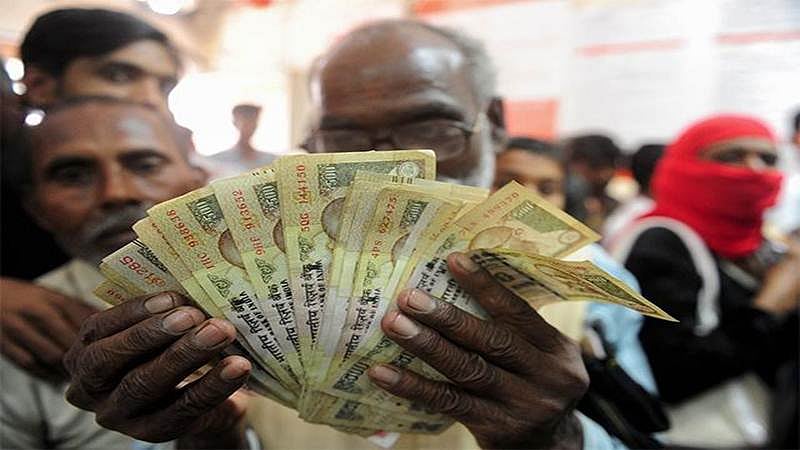De-moo-netisation, or cow deprivation, was a terrible crime in ancient India, when ownership of cattle was the measure of wealth. Kings gained karma points by gifting cows to brahmans. Conversely, a king stealing a cow from a brahman got it in the neck, as we learn from the story of King Kartavirya, who nobbled Sage Jamadagni’s cow and got his head chopped off by Parasuram.
Cows were Ancient Teller Machines, disgorging wealth in the form of food, fertiliser and fuel. Soil fertility was maintained by cow dung, crops were protected by cow urine, cow dung cakes were great for cooking (and keeping mosquitoes away) and cow milk was a super-food with many delicious avatars: buttermilk, clarified butter (ghee), khoya (dried whole milk), cottage cheese (paneer), which in turn could be transmogrified into heavenly kheer, burfi and other sweets.
And that wasn’t all; cow (bull) power was used for plouging, transportation and irrigation. Cow hide was processed into leather to make footwear, cool clothes, toys and vessels, like wineskins (i.e. the first hip flasks). Cow dung mixed with hay was great for plastering mud walls and floors. Doubtless the horns and sinews had many uses as well. As to whether the ancients enjoyed beefsteaks, the academic jury is still out on that one – cow as currency is one thing, cow as curry is quite another.
Cowmance, or love for cows, was understandable. The cow was elevated to the status of deity and all products of the cow were invested with divine powers. Time passed. Science progressed. India was partially de-moo-netised by the import of chemical fertilisers, LPG and a growing preference for buffaloes and high-yielding foreign cows. Eventually, society was divided along bovine lines; those who believed the cow was sacred and thus not to be eaten and those who saw her as just another farm animal and so, tomorrow’s lunch. A third category regarded “foreign” cows as non-divine and therefore burger-worthy.
Contemporary cowmantics subscribe to the cow-as-Kamadhenu (literally, the cow of plenty) narrative and invest panchgavya (or the five main cow products) with miraculous powers. Among them, the ability to heal virtually any disease, from cankers to cancer and arthritis to Alzheimer’s. Cow dung is said to be an insect repeller, have amazing thermal properties and provide an infallible shield against radioactivity. Recently added to the narrative is “A1 and A2” milk; i.e. the milk of Indian cows (A2) is much safer than that of “foreign” cows.
New-age cowmanticism demands that the divinity of the cow be sanctified by “science”. Thus, Rajasthan education minister Vasudev Devnani, instructs us that cows inhale and exhale oxygen and therefore, sheer proximity to a cow will cure coughs and colds. He further tells us that cow dung is rich in vitamin B, enabling it to soak up radioactivity. People, he adds, need to understand the “scientific significance” of the cow. Doubtless, he meant the desi variety of cow – bos indicus – and not the Jersey/Holstein cross-breeds.
Similar ruminations over ruminants make it hard to separate myth from reality, like telling a counterfeit Rs 2,000 note from a real one. Here’s what we know so far. Yes, cow dung is a great fertiliser and soil conditioner, light years better than the chemical stuff. But so is buffalo dung. Cow/buffalo products produce effective bio-fertilisers and bio-pesticides. Some studies have shown that the milk of A1 cows can have adverse health effects whereas that of A2 or native Indian cows does not. Ditto buffaloes, which aren’t sacred. Conclusion: sustainable agriculture needs cattle.
Research on cow urine distillate has found that it may be a bio-enhancer, intensifying the action of anti-infective and anti-cancer agents. There’s none to show that popping cow urine tablets or “ark” has curative powers. Or that it cures leucoderma, snake-bite, jaundice or epilepsy. Likewise, there’s no evidence that cow ghee fixes rheumatism or that cow dung heals skin lesions and piles or that cow horn fumes clear chest congestion. Cowpathy has yet to make the transition from pseudo-science to alternative system of medicine.
The thermal properties of cow dung are manifest, which makes it an excellent and inexpensive insulator when applied to walls and floors. Whether it will protect you from being fried by radiation from a nuclear explosion is doubtful; we can only hope that Mr (or acharya) Devnani never has the opportunity to test his hypotheses in field conditions.
Having said that, science does tend to change its mind. Cow ghee, for instance, has turned full circle, from being good for health to bad to good. Agro-chemicals have gone from being miraculous to horrible for the environment. As of now, there’s a scientific argument for re-moo-netising India, given the importance of cattle in agriculture. Whether that translates into inhaling cow exhalations, swilling cow urine and applying cow dung face packs is debatable. ‘Nuff said.
The author is a senior journalist with 35 years of experience in working with major newspapers and magazines.
She is now an independent writer and author






